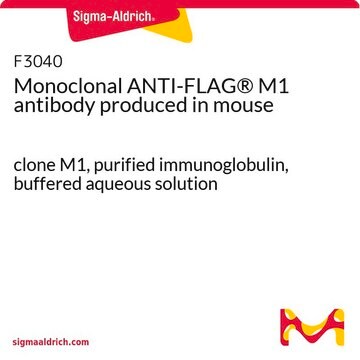おすすめの製品
由来生物
mouse
結合体
CY3 conjugate
抗体製品の状態
purified immunoglobulin
抗体製品タイプ
primary antibodies
クローン
M2, monoclonal
形状
buffered aqueous solution (Supplied as a solution in 10 mM sodium phosphate)
化学種の反応性
all
濃度
~1 mg/mL
テクニック
direct immunofluorescence: 10 μg/mL using mammalian cells fixed with methanol:acetone
アイソタイプ
IgG1
免疫原配列
DYKDDDDK
輸送温度
dry ice
保管温度
−20°C
類似した製品をお探しですか? 訪問 製品比較ガイド
詳細
アプリケーション
製品の詳細については、FLAG®アプリケーションポータルを参照してください。
ウェスタンブロッティング(1報)
物理的形状
調製ノート
その他情報
法的情報
Not finding the right product?
Try our 製品選択ツール.
保管分類コード
10 - Combustible liquids
引火点(°F)
Not applicable
引火点(℃)
Not applicable
適用法令
試験研究用途を考慮した関連法令を主に挙げております。化学物質以外については、一部の情報のみ提供しています。 製品を安全かつ合法的に使用することは、使用者の義務です。最新情報により修正される場合があります。WEBの反映には時間を要することがあるため、適宜SDSをご参照ください。
Jan Code
A9594PROC:
A9594-BULK:
A9594-VAR:
A9594-5X1MG:
A9594-.2MG:
A9594-1MG:
A9594-BULK-N:
試験成績書(COA)
製品のロット番号・バッチ番号を入力して、試験成績書(COA) を検索できます。ロット番号・バッチ番号は、製品ラベルに「Lot」または「Batch」に続いて記載されています。
この製品を見ている人はこちらもチェック
ライフサイエンス、有機合成、材料科学、クロマトグラフィー、分析など、あらゆる分野の研究に経験のあるメンバーがおります。.
製品に関するお問い合わせはこちら(テクニカルサービス)

















